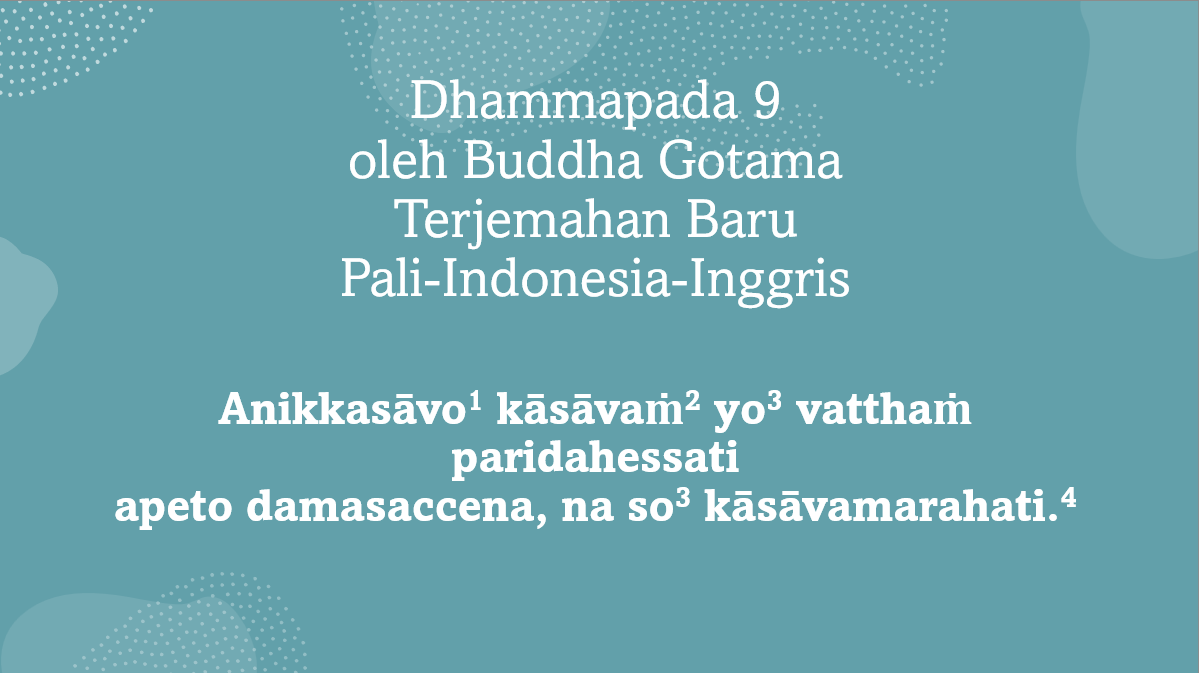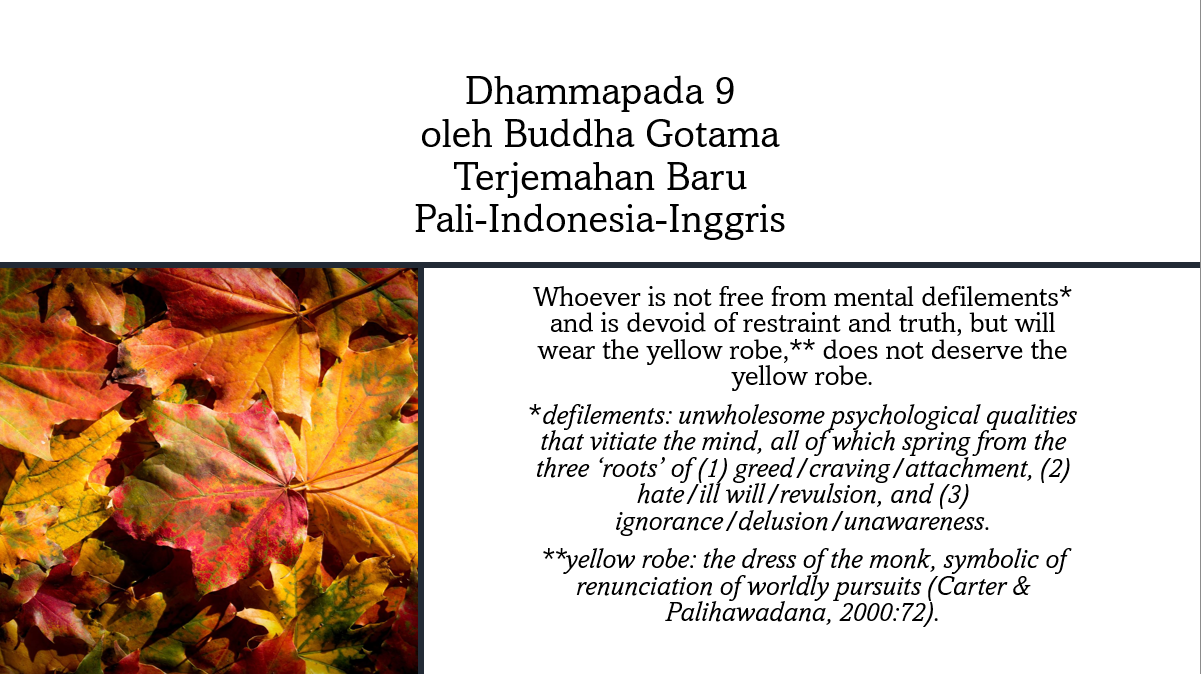Yamaka Vagga



Vocabulary 1 |
Vocabulary 2 |
yo (sg.masc.nom. of the rel. pron. ya ‘he who’ = he whovatthaṁ: vattha (nt.) = garment, robe; vatthaṁ (sg. acc.) = garment, robeparidahessati (3rd pers. sg. fut. act. indic. derived from pari (pf. ‘around, complete’ +√dhā ‘put’ = will put onapeto: apata (adj. & past part. of apeti), comprised of apa (pf.) ‘away from’ +√i ‘to go’= devoid of, (med. deprived of); apeto (sg. masc. nom.) ‘devoid of’ |
damasaccena: (a) (inst. nt.) by, with, or of, restraint and truth; (b) euphonic union, or sandhi of damasacca + -nā ‘by, with;’ (c) damsacca: union of dama (nt.) ‘restraint’ + sacca (nt.) ‘truth;’(d) dama: derived from √dam ‘to domesticate, to tame’ + -a, a suffix used to form an action noun from a verbna ( part.) = no, notso (sg. masc. nom. of the demonstr. pron ta ‘it, that’ = hekāsāvamarahati: kāsāva (adj.) = yellow; kāsāvaṁ (sg. acc. nt.) = yellow; arahati (3rd pers. sg. pres. act. indic.), derived from √arah ‘to deserve’ = deserves; kāsāvaṁ + arahati = kāsāvamarahati = deserves the yellow (robe) |
Pali Grammar
1The form is a double negative, a- ‘not, without, or devoid of’ + ni- ‘without, down’ + kasāva ‘mental defilement,’ not without mental defilement, impure’
2kāsāvaṁ, or kāsāvaṁ vatthaṁ: the yellow or reddish yellow robe donned by members of the Buddhist Religious Order. There is a play on words in the above stanzas; anikkasāvo’ meaning, not free from faults of moral defilements and therefore, stained; and kāsāvaṁ, the yellow robe, dyed somber in some astringent juice and is therefore stained (Tin, 2003:5)
3(a)(i) the construction with a double pronoun, that is, a relative pronoun (e.g., yo) …, a demonstrative pronoun (e.g., so) …. is typical of a Pali sentence with a relative pronoun phrase acting as the subordinate clause and the main clause following it after a comma (also known as the ya + ta construction); in this construction, the demonstrative pronouns so, sā, and taṁ are used as co-relative pronouns [Duroiselle, 1915/1997:153, No.592(1)]; (ii) The relative clause regularly precedes the main clause. The relative word introduces the clause, but may be preceded by indeclinables connecting the whole sentence to the narrative of which it forms a part (Warder, 1963/2001:71)
(b)so: 3rd. pers. masc. sg. ‘he;’ the third person singular so refers to a remote person, and the third person singular ayaṁ refers to an adjacent one; so is also a demonstrative pronoun and used pleonastically; the demonstrative pronoun yo is less frequently used (Tilbe, 1899:102, Nos. 305 & 306)
4kāsāvamarahati: a euphonic combination of kāsāvaṁ+arahati with the niggahīta ṁ in kāsāvaṁ becoming m because it is followed by a vowel, namely, a in arahati (arahati= arhati (Geiger & Norman, 2005:22) (Duroiselle, 1915/1997:15, No.42): taṁ+ atthaṁ= tamatthaṁ; yaṁ+ahu= yamahu; kiṁ+etaṁ= kimetaṁ. Note: sometimes the niggahīta transforms into d before a vowel, e.g., etaṁ +attho= etadattho, etaṁ+eva= etadeva, etaṁ +avoca= etadavoca, yaṁ+idam= yadidam (Duroiselle, idem., No. 43).
|
English 1: |
English 2: |
|
Whoever being depraved, devoid of self-control and truthfulness, should* don the monks’ yellow robe, he surely is not worthy the robe. *In English and Indonesian, this auxiliary verb should not be used, as this stanza refers to what is an eternal, or general, or universal truth [Hands, 2011:208, No. 410; Thomson & martinet, 1986:159, No. 173(A); https://byjus.com/question-answer/give-some-examples-of-universal-truth/] |
He who is not free from taints of moral defilements (kilesas) and yet dons the yellow robe, who lacks restraint in his senses and (speaks not the) truth is unworthy of the yellow robe. |
|
Indonesia 1: |
Indonesia 2: |
|
Barangsiapa belum terbebas dari noda batin, tidak mempunyai pengendalian diri dan kejujuran; ia sesungguhnya taklayak mengenakan jubah kuning. |
Seseorang yang belum terbebas dari noda batin yang ingin mengenakan jubah kuning, yang tanpa pengendalian diri dan tanpa kejujuran. Dia sesungguhnya tidak patut menerima jubah kuning. |




